The Microsoft Surface Pro 6 Review: More Than A Color
by Brett Howse on October 16, 2018 3:01 AM EST- Posted in
- Laptops
- Microsoft
- Surface
- Tablets
- Surface Pro
- Surface Pro 6
Display Analysis
Microsoft has gotten serious about display quality since the Surface 3 launched – and not the Surface Pro 3, but smaller, cheaper Surface 3. That was when they started to individually calibrate all displays on all devices, and the difference was dramatic. The average grayscale error level on the Surface Pro 3 was 6.4, with the display shifted to blue fairly dramatically, but the Surface 3 was 2.49. Since then, the company has refined their calibration, and at this point they are the only PC maker other than Apple to calibrate the displays on every product in their lineup. As such, Surface devices tend to have excellent color reproduction.
But a display isn’t just about accuracy. You also need a resolution that is high enough that you can’t really make out the individual pixels, and Microsoft has kept the same 267 pixels per inch with their 2736x1824 12.3-inch panel as the previous two generations. For most people, that’s high enough where going higher would just impact battery life for no reason.
Another key feature is contrast ratio, and here the Surface Pro series was lagging somewhat compared to the best in the industry, which includes the Surface Book which offers exceptional contrast. We’ll test that with the 2018 model and see if it’s improved.
Microsoft has also stuck with the sRGB panel in the Surface Pro 6, with the same “enhanced sRGB” mode available in the Windows 10 Action Center. To quote Microsoft on the matter:
“The Enhanced setting on the New Surface Pro is a profile within the sRGB space where through special hardware and proprietary color processing we take the mid-tones as close to P3-D65 color gamut as possible while leaving skin tones as is. The overall color contrast is also enhanced.”
So the skin tones are unaffected but other colors are made more vivid. Although the Surface Pro series is generally incredibly accurate, running in a pure sRGB mode can feel a bit dull to some customers, so those customers can leverage the enhanced mode for a less accurate, but more punchy color scheme. Those that need or want sRGB can have it with the tap of a button. It’s a good compromise since they’ve stuck with the sRGB panel again this year.
Microsoft wants to showcase their platform with Surface, and on a device like Surface Studio they’ve done that, offering sRGB, P3 D65, and DCI-P3 gamut support, but with the move to HDR as well as wider color gamuts, it was disappointing to not see any of the Surface lineup offer HDR support. Perhaps the Surface Pro isn’t the right vehicle for this though, due to the power requirements of HDR impacting battery life, but if Microsoft is going to continue to push technology in the Surface series, it’s something we should be expecting soon.
To test the Surface Pro 6 display, we use SpectraCal’s CalMAN software suite, along with an X-Rite i1Display Pro colorimeter for brightness and contrast readings, and the X-Rite i1Pro 2 spectrophotometer for color accuracy testing.
Brightness and Contrast
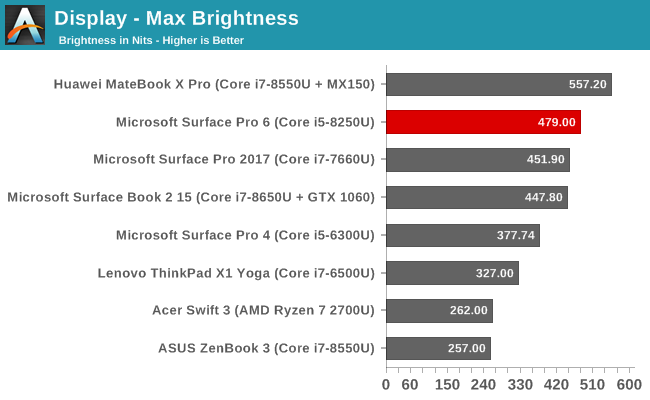
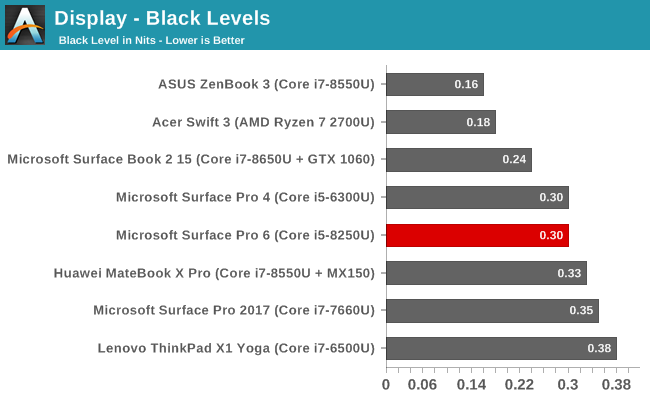
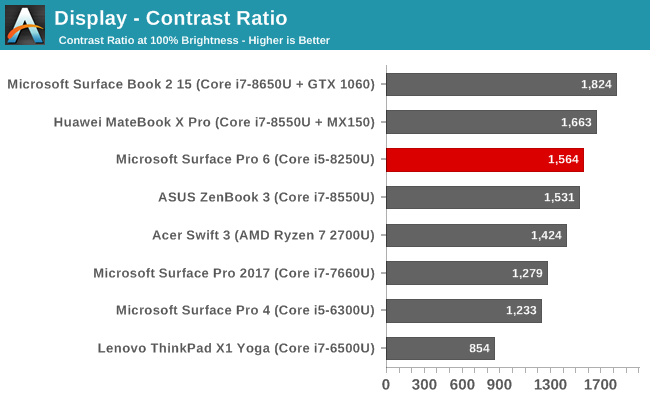
The Surface Pro 6 does improve overall peak brightness somewhat compared to the previous model, but the big improvement is the black level, which is significantly better on the latest Surface Pro, bumping the contrast ratio up to over 1500:1. The difference may not seem like a lot compared to the outgoing model, but the improved contrast was immediately noticeable when powering on the new device. This was probably achieved by using better aligned panels in the new display. It still can’t quite match the Surface Book 2, but it’s much closer.
Mininum brightness is 5 nits.
Grayscale Accuracy
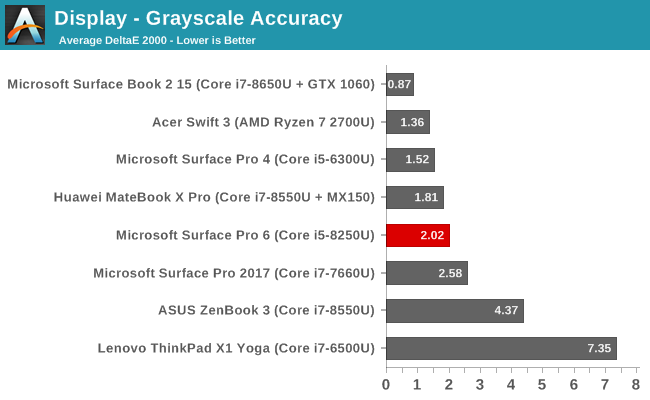
Every review unit is always going to be a bit of a lottery, although hardware calibration at the factory will fix most of the display issues. The grayscale accuracy of the Surface Book 2 we reviewed earlier this year was a stunning 0.87, but the new Pro 6 can’t quite match that, although with a dE2000 well under 3 across most of the range, it would still be considered one of the most accurate displays around. Gamma isn’t exactly at the 2.2 expected though, and the blue levels do drop off a bit as you close in on 100% brightness.
Gamut Accuracy
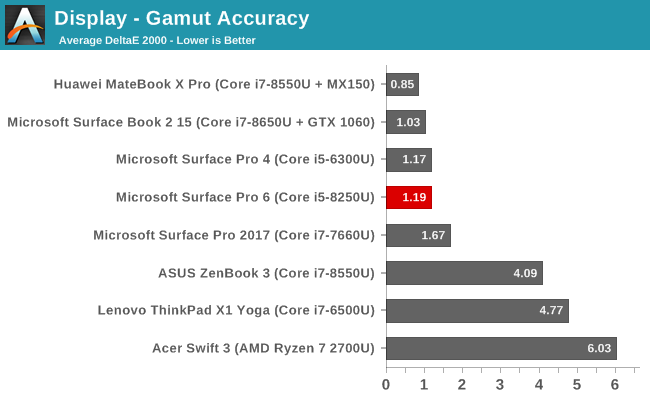
The gamut test checks the 100% levels for all of the primary colors (red, green, and blue) as well as the secondary colors (cyan, magenta, and yellow) and as usual a lower error level means that the display is closer to what it is supposed to be displaying. The Surface Pro 6 comes in with a stellar 1.19 average error level, which is practically imperceptible. At 100% blue, the blue levels are a bit lower than they should be, which is something we saw in the grayscale as well.
Saturation Accuracy

Our saturation sweep tests 4-bit steps across the entire range of primary and secondary colors, and other than the 100% blue levels we had already seen in the other tests, the saturation is almost perfect with an average error level just over 1.0.
Gretag Macbeth
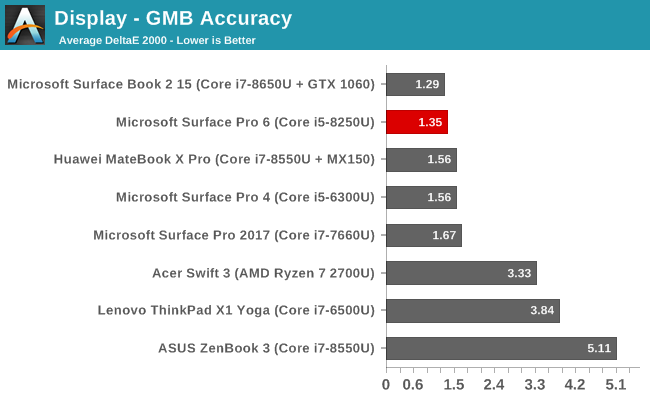
The Gretag Macbeth colorchecker tests not only the primary and secondary colors, but also a wide range other points including the important skin tones. None of the tested colors showed an error level over 3.0, which is excellent, and the overall average error level was just 1.35.
This relative colorchecker shows you the Surface Pro 6 displayed colors on the top, compared to the expected colors on the bottom, and as you can see the display is more or less perfect.
Display Conclusion
We often harp on the power of individually calibrating displays, and this Surface Pro 6 review model is an ideal candidate to discuss why. Here we have a display that shows more or less ideal reproduction of almost all colors, but the display can’t quite hit the full 100% level for sRGB blue. Rather than using an icc profile to correct this, which would likely cause crushing and banding, the entire range of blue is corrected to the best it can be, but 100% blue and just under is a bit off. You can’t use calibration to make a display show more color gamut than it’s capable of, and this Surface Pro 6 unit can’t quite hit 100% blue, but thanks to the calibration, that deficiency is almost imperceptible to the eye.
It would be nice to see Microsoft embrace HDR on Surface Pro in a future model, but the power costs would be high enough that the drop in battery life would likely be disliked by many of their customers.
Overall, as we’ve come to expect with all Surface devices, the display on the Surface Pro 6 is one of the best around, with accurate colors, high resolution, and now, even better contrast.


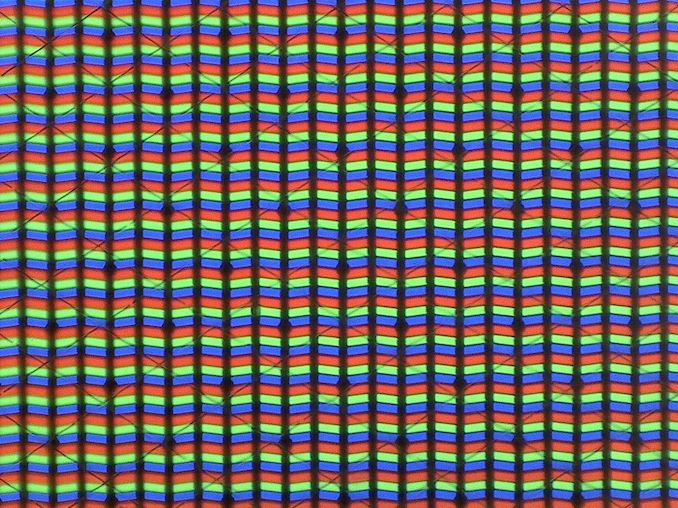













80 Comments
View All Comments
fallaha56 - Tuesday, October 16, 2018 - link
Chip cannot ramp up as much...makes it slow in real life, stuck at 3Ghz instead of hitting 4+wr3zzz - Tuesday, October 16, 2018 - link
Got it. I just checked the i5-8250U spec. Its turbo ceiling should be 3.4Ghz and according to this article the Surface Pro can only hit consistently at 3Ghz before needing to throttle down.Still, I wish more companies would make fanless U-series laptops. Given that prices are basically the same I would like to have choices between 3.2Ghz two core Y-series or throttled 3Ghz four core U-series in various silent form factors.
Brett Howse - Tuesday, October 16, 2018 - link
3.4 GHz will be the max on 1 core though not all 4 cores.krutou - Tuesday, October 16, 2018 - link
Depending on laptop manufacturer settings for max turbo TDP, it is possible to hit 3.4 GHz on 4 cores with a 35-45W short turbo.Clock speeds will ramp down for sustained turbo, and with decent cooling maintain 3.0-3.3 GHz sustained turbo at 25-28W. Laptops with crappy cooling will ramp down more and end up with sustained Cinebench R15 multi scores in the 500s.
khanikun - Tuesday, October 16, 2018 - link
It can hit it's turbo boost ceiling. It's a matter of how long it can stay there that's the downside. Could be a few secs, could be a few minutes. It's more the former, than the latter though.krutou - Tuesday, October 16, 2018 - link
Hell no. There is no point in having a quad-core Intel CPU without active cooling.The 8250U already hits its thermal limit easily in most laptops with active cooling.
If you don't want fans, buy the neutered Y-class CPUs.
damianrobertjones - Tuesday, October 16, 2018 - link
Did you read the review? Did you look at the charts?After doing so I made an order for the i5, 8Gb, 128Gb model to replace my 2017 i5, 4Gb, 128Gb Surface. Done.
For what I do the new i5 model trashes the older 2017 i5.
digiguy - Tuesday, October 16, 2018 - link
It's more complex than just active cooling = no/little throttling, no active cooling = throttling.MS has developed one of the best passive cooling solutions for ULV CPUs, second only to Acer liquid loop, and it has improved it over the years. Hardly any manufacturer manages to do as well. What's more it's even harder in a detachable like the surface. Surface pro 5 outperforms some active cooled 7th gen i5 laptops in sustained loads. So no, it's not just throttling (as it was in surface pro 3) but above all how good the passive heat dissipation is.
fallaha56 - Tuesday, October 16, 2018 - link
so, in summary:-no USB-C
-no HDR
-same resolution
-no IrisPro
-likely UHS-I
-slow Wi-Fi, no BT5
-no Spectre / Meltdown hardware fix
Surface owners groaning...count me out for at least a generation, plus the new iPadPro will probably be getting a shout...
damianrobertjones - Tuesday, October 16, 2018 - link
-No need for USB C. Yet. Ish-No need for HDR. See through the marketing. (Yeah, but it would be nice)
-and?
-Did you view the graphs?
-No issues there.
-Pretty poor. At least we have a usb port to add something faster
-True dat.
The iPad is more of a toy when you think about it. I have an i5 4Gb Surface Pro (2017) and the first gen ipad pro (12.5"). The ipad is my web browser and mild gaming while the pro is everything else. But that's me.